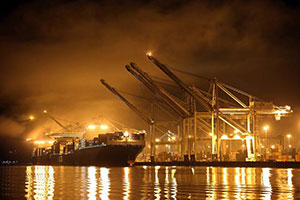Port of Oakland to Keep Extended Night Hours for Trucks

After a three-month pilot program to alleviate truck backups, the Port of Oakland's largest terminal operator is planning to keep its gates open at night and will begin charging a new flat fee to pay for the extended hours.
An unexpected bankruptcy declared by one of the terminal operators at the port earlier this year led to other terminals absorbing more cargo. But with one fewer terminal, truck drivers now have fewer places to pick up or drop off containers.
Al Mota, a driver for Ally Trucking Co., said he often had to wait two or three hours just to get inside the terminal. Once inside, Mota said it could take several more hours before he was able to drop off or pick up a container. A half dozen other drivers shared similar experiences.
RELATED: Port of Oakland App Tells Truck Drivers Wait Times
Since Mota gets paid per container, the longer it takes him to cycle through the terminal, the less money he makes.
"You make good money if the port works with you," he said. "But, if they don't, you don't make any money."
So, when Ports America closed the Outer Harbor Terminal in March, the port kicked in $1.5 million to help pay for the extended hours at SSA Marine's Oakland International Container Terminal, which had absorbed 90% of Ports America's cargo. SSA also contributed $1.5 million for the extended hours pilot program, but SSA President Edward DeNike said the company had few other options.
"The volume here is too much to give truckers the service that they want in one shift," DeNike said. "We just can't do it, and I don't think anybody can do it."
And it appears to be working, said John Casem, a driver for Agile Transportation Inc.
"When the other terminal closed, it made traffic worse," Casem said. "It was bad, but since they've had these new hours, it's lightened up traffic in the morning."
The $30 flat fee, which will go into effect in July, will be assessed on each laden container coming in and out of the terminal. Trucking companies will have to pay that fee, though some may pass it on to customers. DeNike said the terminal would reassess the fee after 90 days to make sure it's working.
"No one likes fees," said Chris Lytle, executive director at the Port of Oakland. But labor costs money, and operators pay a premium for stevedores to work at night. "There was no other way to get the job done."
Increasing the port's ability to move cargo is imperative for the port to remain competitive, said Peter Friedmann, executive director of the Agriculture Transportation Coalition, a national trade group representing agriculture exporters.
"No port in this country can presume that it can remain in existence unless it's competitive and efficient," Friedmann said, pointing to the Port of San Francisco, once the largest on the West Coast, as an example. "The cargo that moves through the Port of Oakland can, if efficiency is not restored, be moved to the ports of Los Angeles and Long Beach, and much of it could move to the East Coast ports."
The port is a major economic engine, supporting more than 73,000 jobs in the region and an estimated 827,000 across the country, port officials said. It's the primary location for exports on the West Coast and a vital gateway for domestic agriculture producers and manufacturers to ship their products to foreign markets.
Ports America represented up to 30% of the port's business, Lytle said, adding that it was essential for the cargo owners to find homes within Oakland, rather than see their business migrate to Southern California or Washington state.
"Our main objective ... was to keep our customers in an Oakland terminal," Lytle said. "If we had not done that ... some of the shipping lines might say, 'Maybe we won't call Oakland,' or 'Maybe we'll suspend Oakland in the lineup for a while.'"
Some of that has happened, Friedmann said, when labor disputes at the port in the early 2000s ground work to a halt. A portion of the business lost during that work stoppage never returned, he said.
The shipping industry also lost an estimated $6 billion during the Great Recession, said Mike Jacob, vice president of the Pacific Merchant Shipping Association, which represents terminal owners and operators. And while the port reported last week that exports reached a 17-month high after five months of consecutive gains, Jacob said total shipping volumes industrywide last year were about where they were 10 years ago.
In addition to the extended night hours, DeNike said SSA has instituted an appointment system for truck drivers in an effort to make the pickups and drop-offs more efficient.
For its part, the port is trying to make wait times more transparent. Last month, it launched a free smartphone app called DrayQ, which tells truck drivers how long it will take to enter a terminal gate and then calculates how long drivers must wait to complete transactions.
The port also is preparing to open a rail yard, plans to start construction on a cold storage facility and ultimately will be adding warehousing space that will improve the port's ability to move cargo, Lytle said.
"Rail is really the ticket for going forward," he said. "We don't want the trucks ending up in West Oakland."

